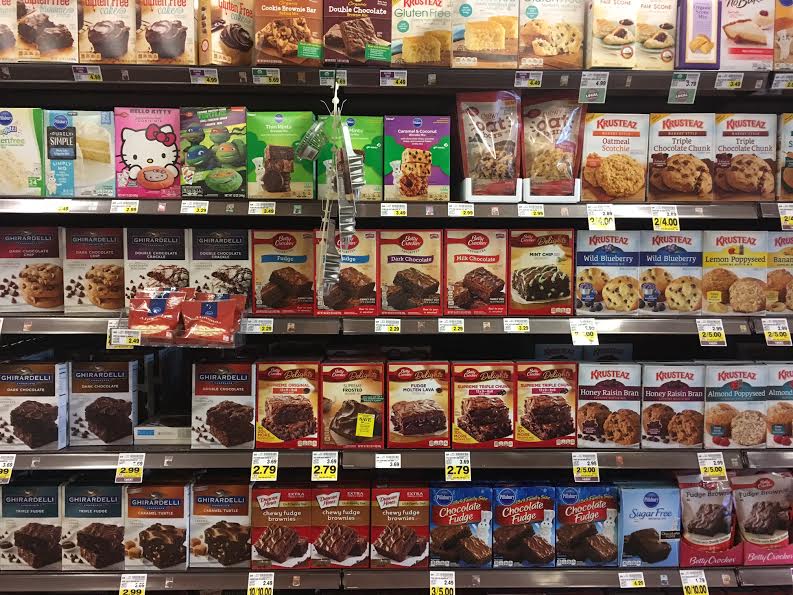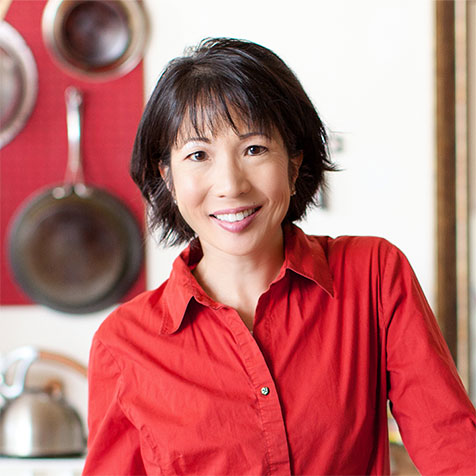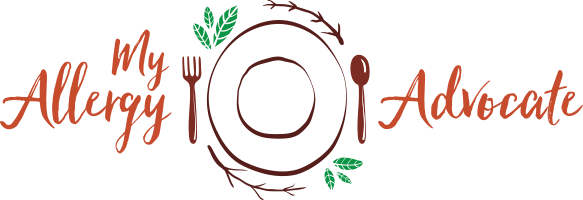
We are trapped in Betty Crocker Syndrome, and our bodies pay dearly for it. Is there any way out? [Photo taken at my local supermarket].
In my first post, I proposed that because of the way Betty Crocker Syndrome [BCS] works — that is, we are hooked on convenience foods until they stop working for us — it appears that Americans are trapped in a BCS cycle that includes poor health, fatigue, fogginess, excess weight (likely due to the amount of sugars, fat, and salt found in a single serving), and other food-influenced diseases. Whether we eat convenience foods. or rely on others to cook our foods for us to the point that we are out of tune with the score of ingredients found in them, we end up in the same places.
Sick. Fatigued. Overweight. Poorly nourished. Anxious. Depressed.
I don’t like the way that sounds. Do you?
In the first post, I suggested that one of the ways we can heal ourselves of Betty Crocker Syndrome (BCS), a fictitious syndrome I created to describe the effects of convenience food eating and the war against eating real food that gained footing in 1950’s America, was to understand how we got here in the first place.
Convenience foods, including meals and desserts that could be poured from a box or package, or frozen meals and fast-food meals, transformed the way people related to food. The essential message we received from the food industry is that they could “do it better, faster, and smarter” than a person who shopped for his or her food at the grocery store and cooked simple ingredients. Why, they were food scientists (truth)! They spent millions of dollars engineering your food (truth). They could save you time and money (truth). Maybe they could even save your marriage and family by keeping everyone happy at mealtimes with quick and easy eating solutions (subjective truth).
In some cases, convenience foods may have even saved lives.
The rest of this post contains my thoughts on the landscape of BCS, as well as my conclusion about what we can do about healing ourselves of it. I could wax eloquent for many pages, so I’ve narrowed it down to give you a good sense of the players on the stage.
BCS Case #1: Top Ramen
On January 9, 2007, Momofuku Ando, the inventor of Instant Ramen and Cup Noodles, died at age 96. In an article written by New York Times journalist Dennis Havesi, Ando was described as bankrupt at 49 years old when he became interested in experimenting with dehydrated noodles and chicken-flavored spice packets requiring only boiling water to create a hot meal. Ando had witnessed people in post-war Japan lining up for a bowl of ramen, and his invention would later create a company, Nissin Foods, that made over 46 billion food packets and instant-meal cups.
We may never know how many lives he saved from starvation. And you have to understand that the amount of Top Ramen consumed worldwide had to have fed more than poor college students in America. I could probably make a case for other packaged foods and modern meal replacement bars, MRE’s (Meals Ready to Eat), and shakes, which America has sent to war-torn and famine regions of the world. I don’t think you will find a pantry or shelter for the homeless that doesn’t include boxes of quick-meal solutions, such as Mac n Cheese, or Top Ramen noodles. I do think you should know that even if offered the nutrient-dense option of an EPIC bar against a square of Top Ramen, those lining up in soup kitchens across America are more likely to select the Top Ramen, because they recognize it as food.*
My point is that the inception of many of these convenience foods were intended for occasional eating, not for long-term subsistence consumption. However, as these foods were accepted into the modern eating routines, such as eating breakfast cereal fortified with vitamins instead of a hot meal from simple, nutrient-dense ingredients, our tastes changed, even if our biology did not.
Food manufacturers capitalized on making convenience foods that would replace real-ingredient foods, pumping billions of dollars into research to make perfectly engineered food products that meet the demands of flavor and texture delivery. Our foods were replaced with what I call “phoods” – real ingredients mimicked by engineered ingredients and added preservatives, colors, and emulsifiers that stabilized the food for longer shelf lives.
Unfortunately, many people are only learning now that maybe all that time and money saved by eating convenience foods or relying on someone else to arbitrarily cook our food has caused us to actually lose time, and gouged our pockets by way of healthcare-related costs. Convenience foods high in sugars, fat, and sodium have contributed to health problems such as obesity, Type II Diabetes, blocked arteries, and risk of stroke and heart disease. But we don’t even have the figures to estimate how many days of lost employment people experience from bad belly aches and digestive issues, headaches, joint pain and inflammation, depression or anxiety triggered from eating these processed foods on a regular basis.
BCS Case #2 Soylent
Let me be blunt and brief about Soylent. Soylent is a new food product designed to deliver calories, vitamins and minerals, and prevent people from wasting time in the kitchen. Soylent claims on their website that it is a simple product that makes nutrition affordable at about eight dollars a day.
Because I am highly reactive to soy products, I cannot risk my own health to even sample Soylent 2.0; therefore, I am reliant on third-party reviews of their drink and powder formulations. Those who have reviewed it thoroughly, and those few I was able to ask directly, agree that Soylent, while passable as a palatable flavor, causes gas and should not be relied upon as a replacement for eating.
Rob Reinhart may have invented Soylent with the hope of disrupting the food industry, but the only thing it will do for healing or beating BCS is turn programmer bros who never liked cooking food to start with into examples of people who may quickly turn to BCS Case #3 (Subscription Box Meal Delivery) as a respite from its obnoxious side effects and boring flavor.
[Unless, of course, they enjoy lighting their farts on fire.]
BCS Case #3 Subscription Box Meal Delivery
Subscription Box Meal Delivery programs, such as Hello Fresh and Blue Apron, came on the scene, and people who had money but either didn’t know how to cook or had no time to shop for ingredients received meals in a box, a recipe and a picture of the finished meal, and a non-judgmental introduction to cooking food at home. The idea: no waste of time or ingredients, everything done for you (shopping to measuring), and all you had to do was assemble according to instructions.
On the surface, the subscription box meal is a clever solution to the problem of getting busy professionals to cook meals at home without the pain of shopping, wasting food, or learning the art of meal planning.
It’s weakest link, however, is that the consumer — that is, YOU, the eater — is at the mercy of the people who designed that meal and choose your ingredients for you.
Let me say without mincing words, if you or the people you are cooking food for have food allergies, intolerances, sensitivities, or a GI or autoimmune condition requiring a medically necessary diet, you really have no business purchasing these subscription meal boxes. Ever. These subscription programs did not design these meals with you in mind, and while they will happily take your money, they aren’t responsible if you get ill. You can’t see how your food was sourced; you are still removed from process of farm to table.
For everyone else, there may be some worth in trying them, but be forewarned that recipes may include more salt, sugar, and trans fats in order to improve the flavor. It’s up to you to figure out if the meals will improve your health or energy levels. By developing a “tuned-in” relationship with your body, a subscription meal in a box plan might actually work.
BCS Case #4 Dining Out
How would you feel if your favorite fine-dining restaurant didn’t know the true ingredients of the food they were about to serve you?
This is, unfortunately, my experience in the world of fine dining as well as the world of casual dining. To be fair, I describe a fine dining experience to involve the following:
- A primary head chef, in a prominent restaurant that is not a chain restaurant (i.e. responsible for a single restaurant location)
- Food is fresh, primarily prepared, assembled, cooked, and plated at the restaurant location.
- Main courses begin at $30 per plate, with side dishes considered extras to be ordered separately.
- There is usually a wine specialist or sommelier on site to help you pair your food.
- Often the environment is more formal and may include a dress code (in cities like Seattle, the dress code is usually not as formal unless otherwise stated); shirt, non-athletic shoes, and tie may be expected or required.
In both fine and casual dining experiences, I run into the same problem. When I order from the menu, I must ask many questions of the server, such as what kind of oils are used in the cooking process, are any of the meats marinated, and what, if anything are the pomme frites dusted in.
Yes, these simple-looking skinny French fries, which my server has glowingly reminded me will be cooked in a gluten-free fryer, may have already been dusted with cornstarch and/or flour. Wheat. Flour. Which pretty much spells gastrointestinal decimation for quite a number of people who cannot have wheat gluten in their food, gluten-free fryer or not.
I have been on the receiving end of a shocked expression from a manager of a restaurant who did not know the fries served in her restaurant were dusted with cornstarch and flour before being frozen, packaged, and shipped off to her location. I have been on the receiving end of a mortified server, who notified me after I ate a food, that the olives they served me did indeed come in contact with alliums.
Counting the number of times chefs, servers, managers, and supervisors have come out to talk to me about their food, it is the extremely rare stand-alone fine dining restaurant that knows exactly what is in their food. And when they do, you can almost bank that the food was not previously frozen, dumped from a box, or poured from a bottle or can. It also comes with a hefty price tag.
BCS Case #5: Betty Crocker Supermoist Dark Chocolate Cake

I still remember what Betty Crocker Super Moist Dark Chocolate cake tastes like, though it’s been decades since I’ve had a slice. Photo from my local grocery store.
I’ve already shared with you in my first post how my experience baking my first cake in the Brownies troupe changed my life. I made cake! I was a goddess in the kitchen! Until, of course, you could see me less than a decade after that happy moment.
By the time I reached college, I was tired. Emaciated. Anorexic by choice, as food kept making me ill. My cohort of freshmen at the University of Washington lavished compliments upon my frail but thin body how lucky I was to be so trim. I won awards for beauty and talent pageants, boys chased me for dates, and women expressed jealousy that despite all the temptations of decadent foods around, I had managed to dodge them all.
I didn’t dodge temptation. There was no temptation. When foods constantly make you sick, you don’t enjoy eating very much. When I did eat, I wanted the food to be tasty, with no fuss, and not “spendy,” just like everyone else. Yet, when I ate those foods, I got sick for days.
I, like many others, bought into a way of thinking about food: the faster we get the calories in, the tastier the food is, the more time and energy we have to apply to things that matter in our lives, like family, faith, and friends. It was a simplistic equation, served up hot on our plates, and I ate it up. I was a product of BCS, but my body wasn’t having it.
Like many other collegians, I lived in the dormitories and ate cafeteria food. Within weeks of switching from home-cooked meals to cafeteria food, I began having severe diarrhea, headaches, fatigue, and weight loss. As my friends gained their “Freshmen Fifteen” (a reference to the average fifteen pound weight gain among Freshmen eating from a generously-budgeted food card), I withered away to just under 100 pounds. One day, one of my male friends pulled me aside and told me I should buy some baggy pants. “No one wants to see how thin your legs are. You look scary to me.”
The Resident Director of my dorm suggested I go to the campus store and pick up some extra foods for myself. “Why don’t you make yourself a cake?” Well, I did buy a boxed cake with frosting. And Pillsbury Dough biscuits. And Kraft Macaroni and Cheese. And I got sicker. And sicker. And even more sick. I started going to my parent’s home on the weekends to eat the food I was used to, but it didn’t help, since those foods were laden some of the same ingredients that were making me sick at the time.
One day, I found myself laying in the stairwell of one of the university buildings. I had fainted. Here I was, a Nursing student, laying in a stairwell, unable to sit up without the world spinning. My body had given up.
Calories aren’t just calories. My body, as does yours, needs balance. In some cases, as in mine, it needs very specific foods from specific food groups, and it needs the avoidance of other food groups. The more of these convenience and cafeteria foods I ate, the worse I felt.
Betty Crocker Syndrome does not address individual needs. Supermoist Dark Chocolate Cake is engineered to stun your tastebuds with chocolate flavors and sugar, which light up your neurochemistry brighter than Independence Day fireworks. Yet it contained nothing that would save my life that day that I lay helplessly flopping around in a stairwell. It would take another student. who was late to class that day, to do the real life-saving of half carrying, half propelling me to the campus clinic.
The biggest irony of all is that we talk of Betty Crocker as if she was a real person. Yet Betty Crocker was a created, curated personality. She was imbued with a motherly image, and she was represented by an actress hired to portray her. Even her photograph was not a single person, but a composite of seventy-five different women (see my reference to Betty Crocker in Wikipedia for the source; this is also substantiated in Michael Moss’ NYT bestseller, “Salt, Sugar, Fat: How the Food Giants Hooked Us” (Random House, 2013). Yet for decades, women in America tuned into her radio program, watched her on television, read her advice column, and purchased her cookbooks. Women of that era wanted to be like Betty Crocker.
How many of your children owned a Betty Crocker ‘Easy Bake’ oven? There is even a Betty Crocker Gluten Free baking contest, where you must use one of their products in order to win the $5,000 prize. Betty Crocker is alive and well, but she is disguised, lurking in different forms and under different names.
When I ate a piece of that Supermoist cake, or that Macaroni and Cheese, or even that Pillsbury biscuit, the flavor and texture got that food past my tastebuds. Yet, you could say that my systems didn’t not recognize the mixture of ingredients, emulsifiers, preservatives, and processed sugars and transfats as things it knew what to do with, and like an efficient bio waste management system under threat, it went on the attack, destroying whatever it could, and taking down with it the very structure itself, one piece of villi at a time.
When the body doesn’t get the nutrition it needs, it not only feels tired. It can also feel anxious and depressed. Mental health issues are common among the homeless and the hungry, and they are assumed in people with Eating Disorders . When the body doesn’t know when it will be fed nutritious food, it’s not uncommon to hear complaints of hopelessness, and helplessness. I cannot tell you how many times I have asked people standing outside of a supermarket who ask for money because they are hungry, “What can I buy you inside the store?” I buy them fresh, real food, and some canned food that will last a long time without refrigeration. I watch the depression and anxiety melt away from their eyes after a few minutes of eating.
I have a special place in my mind for Supermoist cake. It’s Super Bad. No, it’s Super Hella Destructo Bordering-on-Evil Bad.
I know nutritionists tell you things like, “You shouldn’t label any food as good or bad, but think of everything in moderation.” I hear this line from my clients that I have sent to nutritionists over the years. And I have some specific responses to that thought, and for your sake and my license, I’ll just withhold that thought and smile like a Cheshire cat. I simply disagree. If you want cake so much that you are willing to buy the fresh ingredients to make one, you would not only customize that cake to your specific needs, you would eat less of it, perhaps in an attempt to savor the fruit of your labor.**
Moderation does not work for everyone. For the majority of people who read my blog because they have had to adopt a medically-necessary diet, moderation doesn’t work at all. Even moderation can kill us, one bite at a time.
Healing Ourselves from Betty Crocker Syndrome
If you’ve read this far, I assume you are waiting for “the gold” of this blog. How do we heal ourselves from Betty Crocker Syndrome?
Here is where I reveal that piece of information you are seeking. Here is how I heal our nation from Betty Crocker Syndrome! Ready?
I don’t. I can’t. Because no one person can.
The real solution to healing ourselves from Betty Crocker Syndrome is profoundly simple. Since Betty Crocker Syndrome — and Betty Crocker herself — was created by the food industry giants, the food industry giants actually listened to the people who would potentially buy their foods. Over the years, they adjusted their foods to the changing interests of the people they were relying upon, even preying upon, for profit. Then they groomed the taste buds of the next generation, popping the eyeballs out of youngsters with insane amounts of sugar.
I’m not here to take on the food giants all by myself. To do so would be pointless, and frankly, Power is not the best card I have in my hand to play . But in my studies of the changes of American eating habits over the past century, there is only one solution that makes any sense and has a good track record. The only action that has ever influenced food giants in any direction, positive or negative, has been when customers have changed the ways they spend their dollars.
The answer to healing Betty Crocker Syndrome is found in your wallet. When you don’t buy a product because it is in conflict with your health goals, when you put that box of food back on the shelf and make the food you want from scratch, and when you turn down that fast-food restaurant stop and instead stop off at the local Farmer’s Market for a box of greens and a grass-fed bison steak, your dollars aren’t funding the companies that produce those 60% sugary cereals, candies, and cake mixes. Dollar by dollar, you make more room on the aisles for single ingredient, low process whole foods when you put that high processed food back on the shelf. When you don’t buy it, you contribute to lowering demand. Food producers who want to stay competitive do listen to “the bottom line”. A loss of customer base rattles any business, no matter how large or how old.
Can you imagine what would happen if for even two weeks, people in your community ignored the food in the center aisles of their grocery store, and only bought the fresh stuff located on the perimeter (meat, vegetables and fruits, dairy)? What would happen if grocery store chains across the nation saw a marked drop in sales on fortified sugary cereals, candy, soda, and ice cream? They would freak out and want to know why.
What do you think about that? To know that you, in cahoots with millions of others, have the ability to shift the direction of food producers by simply altering how you spend your money each week on food — doesn’t that blow your mind? You could have an influence on the food industry, and heal your own Betty Crocker Syndrome, one box at a time.
————-
*This anonymous tip comes from a friend in the field who volunteers with a soup kitchen serving my city’s homeless population. I think you’ll find this trend generally true.
** Michael Pollan’s Netflix Original series, “Cooked“. This is also his conclusion in the last episode.




